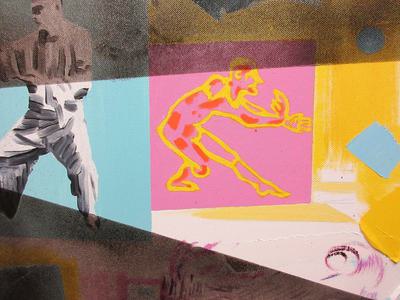At the drop of a hat : Maintaining decorum between land and sea
By
Jane Ostler
2009 - 2013
Jane Ostler
Dimensions
76cm x 101cm x 2cm
Confusion and dysfunction in a painted rendition of Ipswich wildlife in a possible future world.The story of this picture starts with the man and the woman. They have been in other pictures in a similar stance, dancing, flirting or swimming, and they are based on a legendary 1744 Meissen ceramic in the Rijksmuseum Museum in Amsterdam of two commedia dell’arte or traveling players. This time they are dressed in Victorian garb. The reason for this is to reference morals and manners from a former time, the Edwardian childhood of my grandparents and particularly my grandmother.
I became interested in the relationship between land and sea, and where they meet. You can use this as a metaphor for the meeting of the male and female sides of a human being, and the conflict that occurs when there is a push/pull between these impulses. Rational/irrational; scientific/spiritual; safe/dangerous; dead/alive; repressed/liberated.
The man pulled towards the crashing, foaming sea water, his hat lifted off his head by the powerful up draft, the water mutable, waves and droplets forming. The woman stands on dry land with the lion of England standing on her hat. It may be a depiction of Britannia (who used to rule the waves), the waves of change, and the fear of the unknown. Referring back, to the time of our grandparents, can seem safer than looking forwards, because their history has been written, their stories are told, even if open for re-interpretation by a post-modernist. We can draw strength from what they lived through, how they faced up to the challenges of their time eg. Woman’s Suffrage, Votes for Women, Birth Control, WW1, WW2.
Above the lion is an energy saving light bulb, a reference to the current replacement of fossil fuels with new forms of renewable energy.
Three more figures can be added to this tableau. A semi-naked woman standing on a dolphin, waving a flag-uninhibited and unshackled, and free from worry; the head and shoulders of a 1930’s woman with a blond perm, arms folded – who stares at the dancing couple and appears concerned, disapproving; and a firm-jawed woman, wearing long heavy skirts and work boots stands in front of a yellow sailing boat. Her stiff wooden pose offers no clue to her role in this picture. If a fisher woman, she could be judging the frivolity of the others free from the cares of the working class. Or she could be a Victorian swimmer in a bathing suit. She could be a ghostly phantom, willing us to live now, while we can. The sea depth measure painted in red and white stripes alludes to the global climate challenges we face. Can drawing on the past give us courage to face our future and make light of our insignificance?
Jane Ostler
Jane Ostler
Jane Ostler
Helping Artists Keep Going
Axis is an artist-led charity supporting contemporary visual artists with resources, connection, and visibility.







